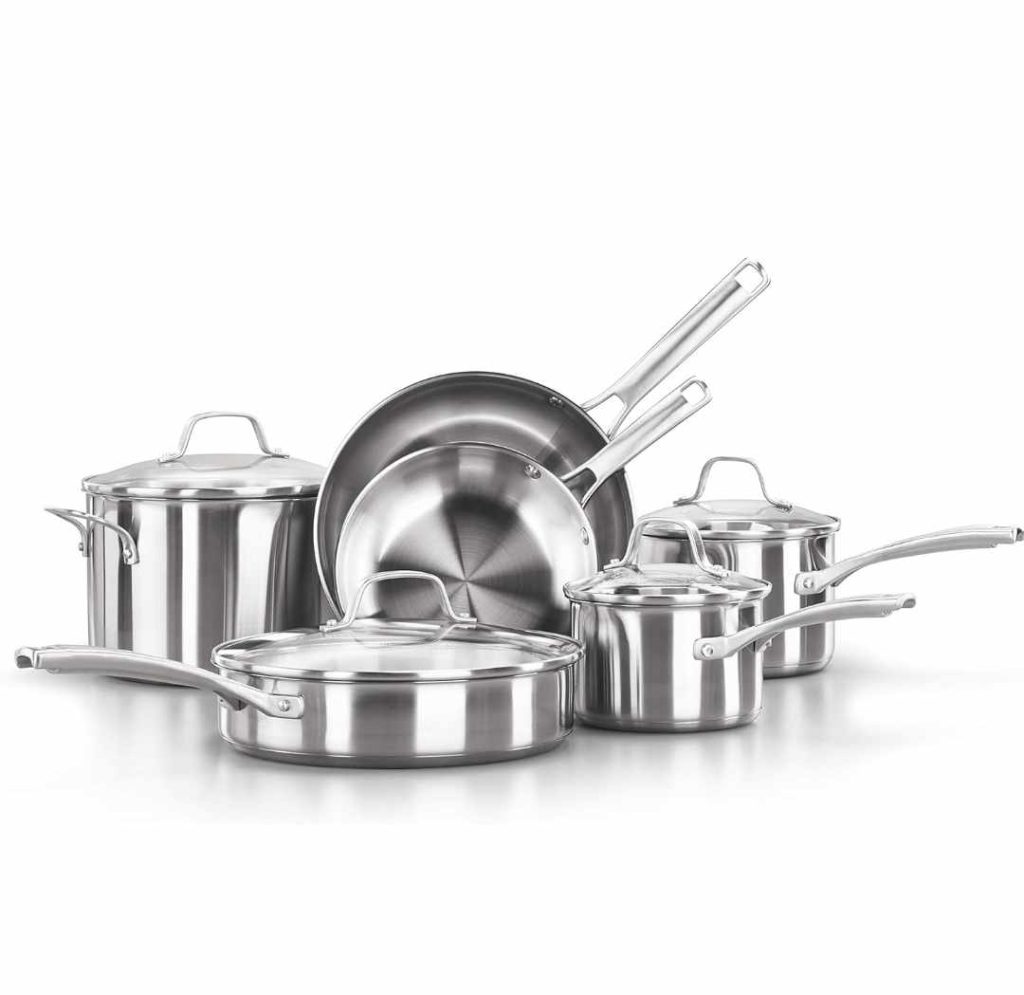This post contains affiliate links. See the affiliate disclaimer here.
If you’re considering purchasing Calphalon cookware, you may be wondering about its safety. Is Calphalon cookware safe? Does it use Teflon to coat its nonstick pans?
In this guide, we’ll delve into the facts to help you make an informed decision. We’ll explore what Calphalon cookware is made of, whether any of its materials pose a safety risk, and how to use it safely. So, let’s get started and find out if Calphalon is the right choice for your kitchen.
Calphalon nonstick cookware is primarily made of two materials: a hard-anodized aluminum base and a nonstick coating made of polytetrafluoroethylene (PTFE).
But what does this mean for your safety? We’ll examine the potential risks associated with these materials and provide you with the necessary information to ensure you can confidently use Calphalon cookware in your home.
Whether you’re a seasoned chef or a beginner in the kitchen, understanding the safety aspects of your cookware is essential. So, let’s dive into the details and discover if Calphalon is a safe option for you and your family.

What is Calphalon Cookware?
Calphalon nonstick cookware is a popular choice for many home cooks, known for its durability and excellent heat distribution. Understanding what Calphalon cookware is made of can help you make an informed decision about whether it is safe for your kitchen.
Calphalon cookware is primarily constructed with two key components:
- Hard-anodized aluminum base: Calphalon cookware is made from hard-anodized aluminum, which is a type of processed aluminum that has been hardened through an electrochemical process. This makes it more resistant to corrosion and provides excellent heat conductivity.
- Nonstick coating made of polytetrafluoroethylene (PTFE): The nonstick surface of Calphalon cookware is coated with a material called polytetrafluoroethylene (PTFE). PTFE is a synthetic fluoropolymer known for its nonstick properties. It creates a smooth, slick surface that prevents food from sticking during cooking.
These two elements work together to create a durable and nonstick cooking surface that allows for easy food release and effortless cleanup.
Calphalon cookware is available in various types and styles, including frying pans, saucepans, sauté pans, and more. The brand also offers different lines and collections, each with its unique features and benefits.
When considering the safety of Calphalon cookware, it is important to understand the materials used and how they are used. The next sections will explore any potential safety risks associated with Calphalon cookware and guide on using it safely in your kitchen.
Is Calphalon Cookware Safe?
When it comes to cooking, using the right tools is just as important as choosing the best ingredients. This brings us to an important question: Is Calphalon cookware safe to use? The answer is yes, but with some nuances to consider.
Calphalon products are made from materials that are generally recognized as safe for food preparation. This includes their non-stick cookware, which is coated with a layer that prevents food from sticking and makes cleaning easier.
Calphalon cookware is primarily constructed with a hard-anodized aluminum base and a nonstick coating made of polytetrafluoroethylene (PTFE). These two elements work together to create a durable and nonstick cooking surface.
One common concern with nonstick cookware is the use of Teflon, which is a brand name for PTFE. However, it’s important to note that Teflon itself is not the issue.
The potential risks arise when the nonstick coating is overheated, causing it to emit toxic fumes. But here’s the good news: Calphalon cookware manufactured after 2013 is PTFE-based and is considered safe to use.
To ensure the safety of your Calphalon cookware, it’s essential to use it as recommended. Here are some guidelines to follow:
- Do not exceed Calphalon’s recommended temperatures ranging from 400 to 500°F. This will prevent the nonstick coating from reaching its smoke point and releasing potentially harmful fumes.
- Avoid using Calphalon nonstick cookware in the broiler. The high temperatures in the broiler can exceed the recommended limits and compromise the integrity of the nonstick coating.
- Use low to medium heat on the stove instead of high heat, especially when searing meat. This will help maintain the quality of the nonstick surface.
- Avoid using metal utensils that could scratch the nonstick coating. Opt for silicone, nylon, or wooden utensils instead to protect the surface and prolong its lifespan.
If you do happen to scratch the nonstick coating or notice it starting to flake, it’s important to replace the pan. Damaged nonstick surfaces can pose a risk to your health and affect the cooking performance of the cookware.
Materials Used in Calphalon Cookware
Calphalon nonstick cookware is primarily constructed using two key materials: a hard-anodized aluminum base and a nonstick coating made of polytetrafluoroethylene (PTFE).
The hard-anodized aluminum base is an excellent conductor of heat, providing even heat distribution while cooking. It is known for its durability and resistance to warping. This ensures that your food cooks evenly without any hot spots, giving you consistent and delicious results every time.
The nonstick coating, made of PTFE, is what sets Calphalon cookware apart. PTFE is a synthetic material that provides a smooth and slippery surface, making it easy to cook with and to clean. It prevents food from sticking to the surface, allowing you to cook with less oil or butter. The nonstick coating also makes for effortless food release, reducing the chances of your food getting stuck to the pan or breaking apart.
With this combination of materials, Calphalon cookware offers you exceptional cooking performance and convenience. The hard-anodized aluminum base provides durability and even heat distribution, while the PTFE nonstick coating ensures easy cooking and cleaning.
It’s important to note that Calphalon cookware is available in various types and styles, including stainless steel and ceramic options. These different materials may have slight variations in their construction and properties, but the overall goal remains the same – to provide you with safe and reliable cookware for your kitchen.
In the next section, we will delve deeper into the safety aspects of Calphalon cookware and address any concerns you may have.
Potential Risks of Calphalon Cookware
While Calphalon cookware is widely regarded as safe and reliable, there are a few potential risks associated with its use. It’s important to be aware of these risks to make an informed decision when selecting cookware for your kitchen. Here are some factors to consider:
1. Nonstick Coating Degradation
Over time, the nonstick coating on Calphalon cookware may start to degrade, especially with extensive use. This can result in the loss of its nonstick properties and may make it more susceptible to chipping. While this degradation doesn’t pose significant health risks, it can affect the cookware’s performance and lifespan.
2. Release of Harmful Fumes
Calphalon cookware uses a nonstick coating made of polytetrafluoroethylene (PTFE). When subjected to high heat, PTFE can release toxic fumes, including perfluorooctanoic acid (PFOA). PFOA has been linked to certain health issues when inhaled in significant amounts.
It’s important to note that the release of harmful fumes typically occurs at extremely high temperatures, well beyond normal cooking temperatures. However, if you accidentally overheat your Calphalon cookware or leave it on the stove unattended, there is a risk of fume release.
3. Allergic Reactions to Nickel
Some individuals may have a nickel allergy, and Calphalon cookware with stainless steel components may contain trace amounts of nickel. Prolonged exposure to nickel can lead to allergic reactions in susceptible individuals. If you have a known nickel allergy, it’s advisable to consider alternative cookware options.
4. Wear and Tear
Like any cookware, Calphalon can show signs of wear and tear over time. Scratches or chips in the nonstick surface can potentially lead to the release of small amounts of aluminum over time. While the health risks of aluminum exposure are still a topic of debate, it’s worth noting if you have concerns about aluminum intake.
It’s important to note that if you properly care for your Calphalon cookware and avoid using metal utensils or harsh cleaning methods, the risk of wear and tear can be minimized.
How to Use Calphalon Cookware Safely
When it comes to using Calphalon cookware, following a few guidelines will help you ensure the safety and longevity of your pans. Here are some important tips to keep in mind:
- Do not exceed recommended temperatures: Calphalon recommends not exceeding temperatures ranging from 400 to 500°F (200 to 260°C) for their nonstick cookware. Going beyond these temperatures can cause the nonstick coating to degrade, affecting its performance and lifespan.
- Avoid using in the broiler: Calphalon nonstick cookware should not be used in the broiler. The intense heat in the broiler can potentially damage the nonstick surface. Stick to using your Calphalon pans on the stovetop or in the oven at safe cooking temperatures.
- Use low to medium heat on the stove: Opt for low to medium heat settings when cooking with Calphalon nonstick cookware. This will help prevent the nonstick coating from overheating and potentially releasing harmful fumes.
- Avoid using metal utensils: To prevent scratching the nonstick surface, it is best to use non-metal utensils such as silicone or wooden utensils. Metal utensils can damage the coating, reducing its lifespan and potentially contaminating your food.
- Replace damaged pans: If you notice the nonstick coating starting to flake or if there are noticeable scratches on the surface, it’s time to replace your Calphalon pan. Cooking with a damaged pan can compromise the safety and performance of the cookware.
By following these simple guidelines, you can ensure that you are using your Calphalon cookware safely. Remember to always practice proper care and maintenance to minimize wear and tear. With the right handling, your Calphalon pans will continue to provide you with reliable and safe cooking experiences.
Now that you know how to use Calphalon cookware safely, let’s move on to exploring other important aspects of its safety.
Conclusion
By following these simple tips, you can ensure the safety and longevity of your Calphalon cookware. It’s important to avoid exceeding the recommended temperatures, as this can lead to damage and potential health risks. Additionally, refrain from using the cookware in the broiler, as the high temperatures can cause warping and other issues.
Using low to medium heat on the stove is also crucial in maintaining the integrity of your Calphalon cookware. This will prevent overheating and help preserve the nonstick coating. Furthermore, it’s best to avoid using metal utensils, as they can scratch the surface and compromise the nonstick properties.
Lastly, be sure to replace any damaged pans promptly. Damaged cookware can be a safety hazard and may also affect the performance of your Calphalon products. By following these guidelines, you can enjoy safe and reliable cooking experiences with your Calphalon cookware for years to come.
Frequently Asked Questions
Is Calphalon ceramic or Teflon?
Calphalon Classic Oil-Infused Ceramic Cookware features a durable, PTFE- and PFOA-free oil-infused ceramic nonstick coating.
What cookware to avoid?
Avoid ceramic-enameled and non-stick cast iron cookware.
Is Calphalon coating coming off safe?
If the coating is peeling or chipping, there could be a harmful additional non-stick coating over the anodized aluminum.
Are Calphalon pans safe to use?
Yes, Calphalon nonstick cookware is safe to use. However, it should not be used in the broiler.
Is Calphalon free of PFAS?
Calphalon’s PTFE- and PFOA-free cookware is made from hard-anodized aluminum and has stainless steel handles.

